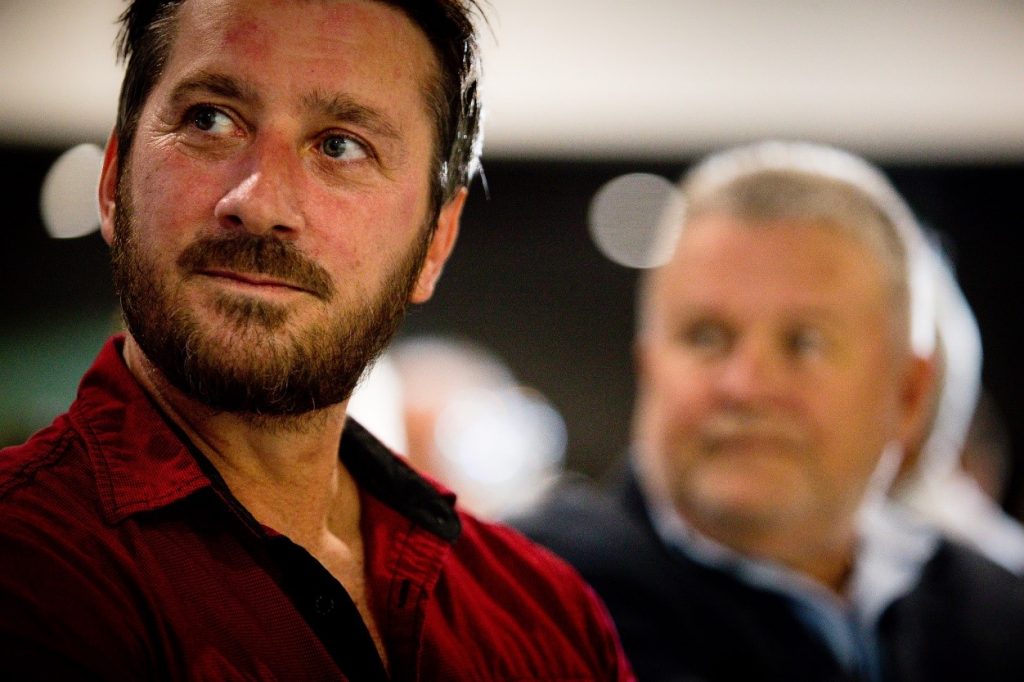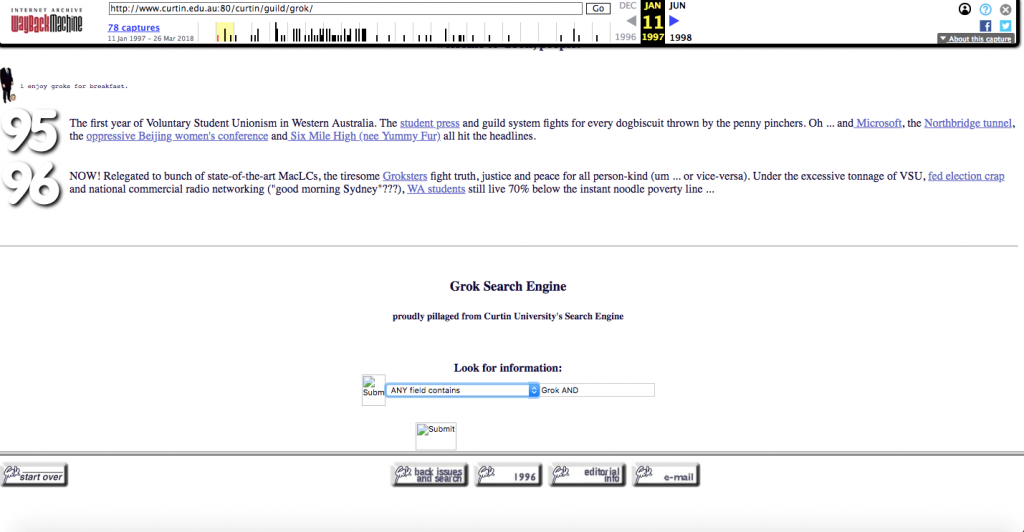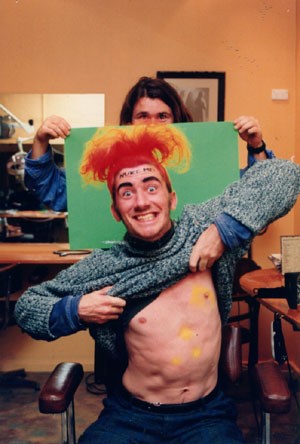Adam Connors finds a quiet corner of the Australian Broadcasting Corporation (ABC) offices in Perth to speak to Grok briefly about his formative years as a Curtin University student, back in the early-to-mid 1990s, when he wrote for Grok Magazine and worked on his Honours in English.
By Luisa Mitchell
But Adam’s only in Perth for a few days, before he flies back to Brisbane where he lives and works as the Network Producer for Regional and Local ABC News.
In a brief reprieve from no doubt some hard-hitting journalism, we took a trip down memory lane with Connors, and picked his brain for memories of his time at Curtin, his experience as a Grok editor, and recollections of his worldly, well-travelled career.
Is being in Perth bringing back any memories for you?
Yeah, having just walked out of the central train station and not having any point of reference at all—I’m just thinking I have no idea where the heck I am!
I mean, to be fair you’ve travelled a lot since leaving Perth. On your website, you describe the work you do as “political coverage, music ramblings and general hijinks across decades, under a range of guises, at several locations, often in a state of awe.” That’s a mouthful—what are you talking about?
The first writing I did was with Grok; like a lot of my contemporaries and a lot of my friends that I still keep up with [did], and it kind of spiralled from there. I think I was a young music journalist with the West and The Australian while I was in Perth, after I was with Grok, and then I kind of leapt into working in Hong Kong. I couldn’t get a proper journo job in Australia because I already had a profile as a music journalist [laughs]. I just grabbed a backpack and went to Hong Kong and got a job at Time Magazine. Only a couple weeks, or a couple months into being there, someone said, “do you know anything about this internet thing?” It was about ’98, ’99. And I said, “well, actually I put my student newspaper online in 1994.” So, they were like, “here you go, here’s Time Asia, we’re setting up Time Europe”. So, myself and two other guys from the US became the central hub for everything outside of the United States for Time Inc, the biggest publishing corporation in the world. It was just the right place at the right time.
We knew at the time when we put Grok online—it went live in ‘95—that this was seriously cutting-edge stuff. We approached the Curtin University webmaster—there was one guy who ran the Internet at Curtin. His name was Martin Dougiamas. He was the head IT guy, titled “webmaster”. I approached him with a couple of other subs [editors], and he said, “look what I have to do, people are starting to latch onto this internet thing”. He showed me how to look at source codes and said, “Learn that!” I went to the Curtin Design school, and said, “Do you have classes in web development?” And they said “No, but we’re thinking of starting one next year”. So then we were put onto another young student called Martin Grant, who came with the look and feel, and helped out with the code, and we all sort of muddled through and got the first two editions of Grok up [online].
A screenshot of Grok’s first online editions, for 1995 and 1996. It was also one of the first 2000 websites ever made. Link to website: http://web.archive.org/web/19970111063822/http://www.curtin.edu.au:80/curtin/guild/grok/.
So, that link you sent me: that’s the first online editions of Grok, ever?
Yes, and it is amongst the first 2000 websites. So, really early. We discovered the power of it initially when we put up the first edition online and it had a Peter Singer interview, and we got an email from the Netherlands asking to reprint it. So, in the olden days that stuff just didn’t happen—that a student newspaper gets asked by a foreign nation to reprint an interview. A generation of us all just went, “woah, okay”—and now all of us still work in digital, in government departments over in the East coast, and all over the place really.
You started off your journalistic career in Western Australia: first at RTRFM Radio, then Curtin’s very own Grok Magazine, and finally at the West Australian. Did you always want to go into journalism?
I believe so; our group was quite unique in that very few of us were doing the Curtin journalism course. We came from the English Faculty, and Design Faculties, and even Psychology and History—and things like that. I’m not sure if it’s still the same—I can’t even remember what the name of the official journalism department newspaper is called … but see, people remember Grok, and not that one. But at the journalism school it was frowned upon if you wrote for Grok. They wanted you to write for this dry, straight, formulaic newspaper that the journalism school was doing, and not the get-yourself-in-trouble, push-the-boundaries, tackle-the-hard-topics-around-student-unionism-and-sexuality, and hold-the-Guild-accountable, that Grok always was. So, there was a bit of a divide there.
That early 1990s group also tried to make Grok the second street magazine in the city, with X-Press. We took the distribution from around 7000 copies on campus, and we pushed it up to 30,000 or so. We got distribution across the city, so you had two options [to read]: X-Press and Grok.
It sounds like those years were almost the “Golden Era” of Grok?
Yeah, it was pretty entrepreneurial.
Sean McEwan, the Grok Editor for 2011, wrote that the “glory days” of Grok were under the leadership of editors such as Ron Schop, Simon Collins and yourself. What did you do to gain such devotion?
Oh, I dunno … I suppose I just let out enough rope so that we could hang ourselves [laughs]. That’s the thing about Grok, is that we all passed down the knowledge. This was a mixture of seeking out great stories, but also making it look good—rather than just laying out on a broad sheet a big pile of words, or some communications studies waffle … you know, another treatise from someone who’s looked at it for six months. But you know, condense stuff, make it look good, run big pictures, do photoshoots. We got other really great young designers from the Design School who became world renowned, like Deanne Cheuk. She used to do design bits and pieces for Grok. But people who would come in and advise, and experiment with sideways covers, like a punch up video game cover, and have prime ministers all bloodied on the front.
We’d encourage everyone [by saying] that this is going to be bigger than just on campus, and that would encourage even more writers to come to the door, and they’d say, “I wanna do a film review”, and we’d say, “Great!” ‘Cause that’s where everyone starts. And it would sort of spiral from there and they’d start to communicate the bigger issues.
There were also some really smart guys before us, like ’93 Guild President Simon Johnson. He was part of a small group of people who decided to make it even bigger than just the Guild, and who were able to get some funding from the Guild to take it to a street-press-type level. Him, and other visionaries like Tim Wallace. It just sort of elevated everything we did.*
We were also really great mates with [WA student magazines] Metior and Harambee, and that other uni rag, Pelican, at UWA [laughs]. And so, every month when we’d all publish, we’d find a spare Thursday night and we’d have something called the Press Club, and we’d all go to the Broadway Tavern and just do silly skits and swap war stories. We worked really hard with other press outlets. It was just generally that perfect time when we had desktop publishing tools that just came in, so that we could actually do layout ourselves; plus, we upped our distribution to give everyone a profile and make everyone feel better about working for nothing, forever [laughs].
Adam Connors (front) and Nathan Lynch (back) posing for Grok cover, c. 1994. Connors went on to work for the ABC, while Lynch is currently the Regional Bureau Chief for Thomson Reuters’ Financial Crime and Risk arena in the Asia Pacific region.
Then not a lot has changed [laughs]! In our correspondence you said you were “hardly a model student” while you were at Grok; what were you up to then?
I was doing my Honours in just a straight English degree. I put that on hold and just did single units to stay enrolled for two or three years. I never actually handed in my Honours thesis because I started getting full-time work. But I do recall going in ‘cause I thought I could ace a Public Relations unit, because I’m built to undermine public relations. So, I sat in the business building with hundreds of other students and I was the only one to get a 100 per cent mark in the business school for that. ‘Cause if you know how to break something, you know how to work the system. And we’re still doing it! Our constant fight [as journalists] is to try and slap away PR and try and get the real story.
Asides from avoiding PR waffle, you also had a responsibility to cover Student Guild issues and politics. What were your memories of the Guild during your time with Grok?
There were people who were close to the Guild that supported the Guild outcomes and wanted to get Guild messages across, and that was fine. We definitely pushed various [Guild] agendas; but there was also a lot of factional infighting within the Guild itself, so we’d call them [out] for various misdemeanours, or [telling] porkies, or giving mixed messages if, you know, they were pushing their own parties’ political agenda.
But we worked very, very closely with the Guild itself, based out of the print shop, and obviously they were our pay masters. Some of the smarter ones [from the Guild] realised that Grok getting great exposure, meant the Guild was getting great exposure. So, it wasn’t adversarial, but it was calling out our own pay masters to account, which always made for interesting times. But the success of this was that it showed the people who weren’t just hung up on the party-political stuff internally, that it was really good for the Guild, because it showed that Curtin is progressive; Curtin is willing to push the boundaries; it’s surfacing people who are genuinely questioning what’s going on in the university itself, and other universities.
Maybe it’s thanks to Grok then that you’re now the Network Producer for ABC Regional and Local in Brisbane … ?
I think across my whole career it’s that multitasking I learnt with Grok that’s always been called upon. I can spell well, I can layout better, I can get across a good idea in a conversation, like now, with yourself. Even with photography—like I could never pick up a camera myself at all, but I know what a good set shot looks like from laying out a magazine. It was the whole kit of journalistic practice and distribution, layout, and the technology behind it, and even the business acumen of taking it off campus, that I’ve been able to carry through from job, to job, to job. It made me a complete old bull, all-rounder, and not just a writer who would never stand in front of a TV, or a broadcast presenter who can’t write in past-perfect tense [laughs].
Do you have any last piece of advice for myself and other Grokians?
I think it’s important to understand all the bits of the process of getting a publication out. Try your hand with a bit of layout and struggle with it; even to attain the terminology you use, like the kerning, or the leading, or the font size is wrong on that, or never use lemonade font [laughs]. Keep pushing the boundaries in terms of the content that you tackle, but remember that it takes every single aspect of the process—from selecting the paperweights and how much that costs, through to how best to distribute it, to how many beers that costs for your friends to dump it around campus. Also, surround yourself with great people, ‘cause they will carry it all through with you.
Originally at Grok Magazine and Curtin University Guild
* Adam 26/5/2020: note that I made an error here in my interview attributing the wrong person to helping Grok in its early days. I’ve corrected who I meant to say in this version.

Ad for Grok editors in the classified section. 1991, Issue 11, p. 39.



